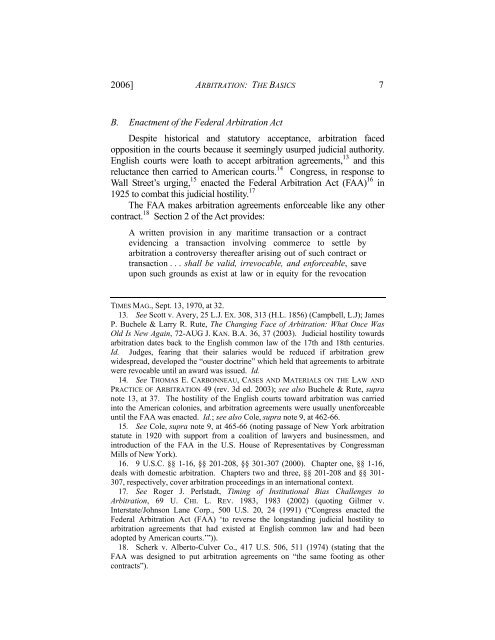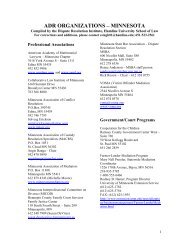2006/Vol. 5 No.1 - Hamline Law - Hamline University
2006/Vol. 5 No.1 - Hamline Law - Hamline University
2006/Vol. 5 No.1 - Hamline Law - Hamline University
You also want an ePaper? Increase the reach of your titles
YUMPU automatically turns print PDFs into web optimized ePapers that Google loves.
<strong>2006</strong>] ARBITRATION: THE BASICS 7<br />
B. Enactment of the Federal Arbitration Act<br />
Despite historical and statutory acceptance, arbitration faced<br />
opposition in the courts because it seemingly usurped judicial authority.<br />
English courts were loath to accept arbitration agreements, 13 and this<br />
reluctance then carried to American courts. 14 Congress, in response to<br />
Wall Street’s urging, 15 enacted the Federal Arbitration Act (FAA) 16 in<br />
1925 to combat this judicial hostility. 17<br />
The FAA makes arbitration agreements enforceable like any other<br />
contract. 18 Section 2 of the Act provides:<br />
A written provision in any maritime transaction or a contract<br />
evidencing a transaction involving commerce to settle by<br />
arbitration a controversy thereafter arising out of such contract or<br />
transaction . . . shall be valid, irrevocable, and enforceable, save<br />
upon such grounds as exist at law or in equity for the revocation<br />
TIMES MAG., Sept. 13, 1970, at 32.<br />
13. See Scott v. Avery, 25 L.J. EX. 308, 313 (H.L. 1856) (Campbell, L.J); James<br />
P. Buchele & Larry R. Rute, The Changing Face of Arbitration: What Once Was<br />
Old Is New Again, 72-AUG J. KAN. B.A. 36, 37 (2003). Judicial hostility towards<br />
arbitration dates back to the English common law of the 17th and 18th centuries.<br />
Id. Judges, fearing that their salaries would be reduced if arbitration grew<br />
widespread, developed the “ouster doctrine” which held that agreements to arbitrate<br />
were revocable until an award was issued. Id.<br />
14. See THOMAS E. CARBONNEAU, CASES AND MATERIALS ON THE LAW AND<br />
PRACTICE OF ARBITRATION 49 (rev. 3d ed. 2003); see also Buchele & Rute, supra<br />
note 13, at 37. The hostility of the English courts toward arbitration was carried<br />
into the American colonies, and arbitration agreements were usually unenforceable<br />
until the FAA was enacted. Id.; see also Cole, supra note 9, at 462-66.<br />
15. See Cole, supra note 9, at 465-66 (noting passage of New York arbitration<br />
statute in 1920 with support from a coalition of lawyers and businessmen, and<br />
introduction of the FAA in the U.S. House of Representatives by Congressman<br />
Mills of New York).<br />
16. 9 U.S.C. §§ 1-16, §§ 201-208, §§ 301-307 (2000). Chapter one, §§ 1-16,<br />
deals with domestic arbitration. Chapters two and three, §§ 201-208 and §§ 301-<br />
307, respectively, cover arbitration proceedings in an international context.<br />
17. See Roger J. Perlstadt, Timing of Institutional Bias Challenges to<br />
Arbitration, 69 U. CHI. L. REV. 1983, 1983 (2002) (quoting Gilmer v.<br />
Interstate/Johnson Lane Corp., 500 U.S. 20, 24 (1991) (“Congress enacted the<br />
Federal Arbitration Act (FAA) ‘to reverse the longstanding judicial hostility to<br />
arbitration agreements that had existed at English common law and had been<br />
adopted by American courts.’”)).<br />
18. Scherk v. Alberto-Culver Co., 417 U.S. 506, 511 (1974) (stating that the<br />
FAA was designed to put arbitration agreements on “the same footing as other<br />
contracts”).
















